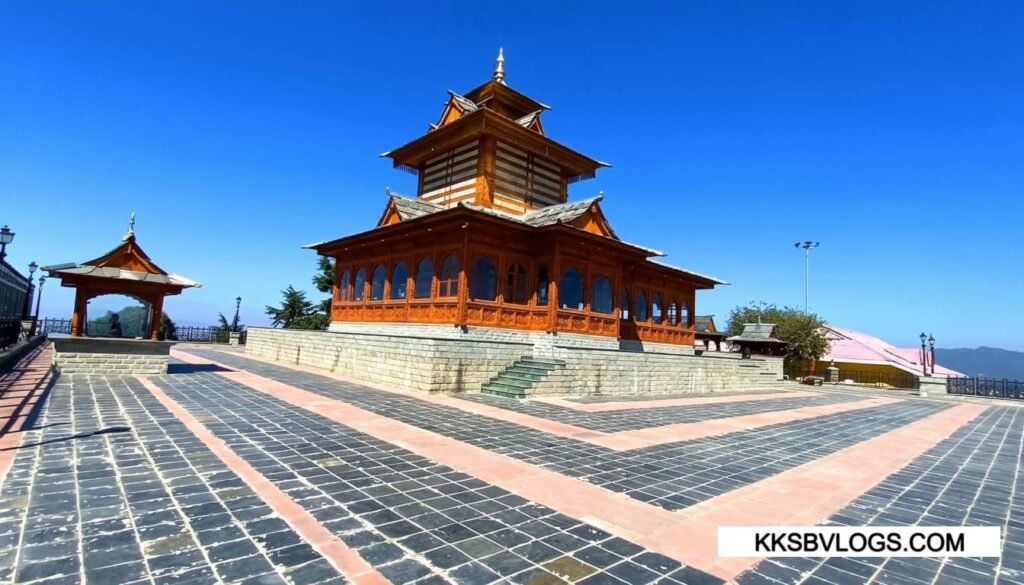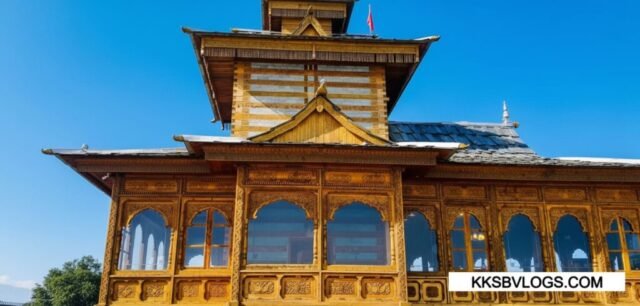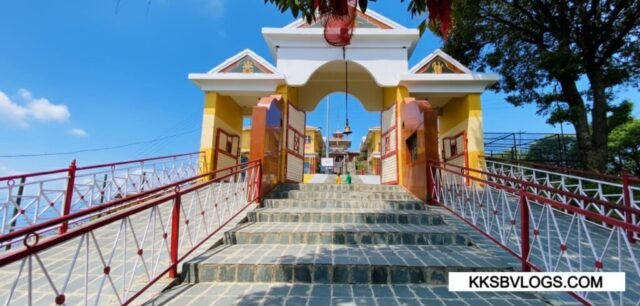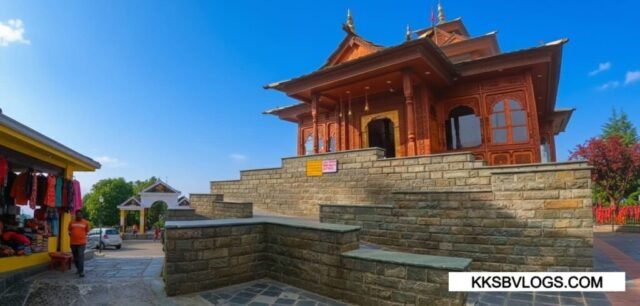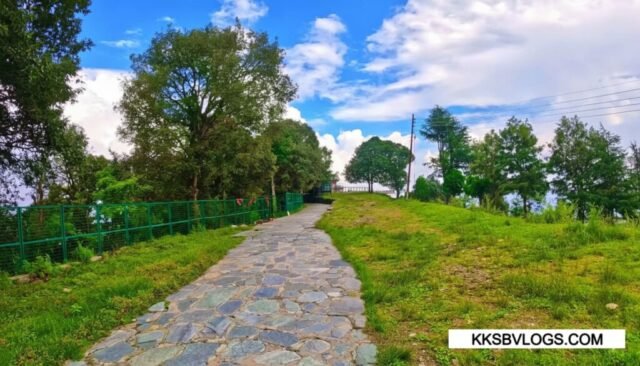Shimla, the Queen of Hills, is famous for its colonial architecture, Mall Road strolls, and the heritage toy train. But if you want to experience the city’s true spiritual essence, you must visit Tara Devi Temple.
Located about 18 km from Shimla on a serene hilltop, this temple is dedicated to Goddess Tara—a manifestation of Shakti and a symbol of protection, courage, and grace.
The atmosphere at Tara Devi Temple is both peaceful and powerful: dense pine and deodar forests, cool mountain air, the rhythmic ringing of temple bells, and a breathtaking 360° view of the Shivalik hills.
For travel photographers, sunrise, sunset, or the post-monsoon clarity offer postcard-perfect shots. In winter, snow-draped peaks against a deep blue sky create a scene that feels almost divine.
One of the biggest advantages of visiting Tara Devi Temple is its serenity.
Unlike the often-crowded Jakhu Temple, this shrine allows you to enjoy darshan, meditate, and soak in nature without the bustle. Whether you’re on a family trip, a solo spiritual retreat, or a slow-travel couple’s getaway, this spot is ideal. Convenient access from NH-22 makes getting here simple and stress-free.
This guide covers everything you need to plan your visit:
history and legends, Himachali pagoda-style architecture, spiritual significance, festivals, best time to visit, how to reach (by road, toy train, or trek), and practical visitor tips.
2) History & Legends of Tara Devi Temple
2.1 Establishment & Royal Patronage
The temple’s history goes back to the 18th century, when it was built under the patronage of the Sen dynasty of Keonthal state.
Originally, Goddess Tara’s idol was placed within the royal complex or at a lower site, but later—guided by royal decree and growing devotion—it was enshrined on this hilltop, so the Goddess’s protective gaze could embrace the entire valley.
2.2 The Dream Legend & the “Star Goddess”
Local legend says that the King of Keonthal had a dream in which Goddess Tara instructed him to build a temple at the summit.
“Tara” means star, symbolizing guidance and light in times of darkness.
That is why devotees pray here for clarity in life decisions, success in exams, business prosperity, and travel safety.
2.3 Idol’s Journey & Living Faith
Another tradition holds that the idol came from Bengal, rooted in the Shakta tradition.
Over time, the temple has been renovated to preserve its wooden pillars, carved beams, and earthquake-resistant design. Even today, local families perform rituals like mundan (child’s first haircut), Navagraha shanti, and Navratri pujas here.
For devotees, Tara Devi Temple is not just a shrine but a heritage of faith spanning generations.
2.4 Shakta & Himalayan Tradition
The Himalayan belt has a strong Shakta tradition, where the Goddess is seen as a protective mother.
Goddess Tara embodies compassion and courage, shielding people from fear, indecision, and negativity.
Whether you are a trekker, a driver, a student, or a shopkeeper, visitors come here seeking sankat-mochan—relief from obstacles.
3) Architecture & Spiritual Significance

3.1 Pagoda-Style Himachali Design
Tara Devi Temple is a classic example of Himachali pagoda architecture with tiered roofs, projecting eaves, and a timber-stone blend that suits the mountain climate.
- Deodar wood beams and carved brackets provide natural insulation.
- Slate or metal roofing efficiently sheds rain and snow.
- Kath-Kuni interlocking wood-stone construction adds earthquake resistance.
The result is both practical and beautiful. As you enter through the carved gateway, intricate floral and mythological motifs, bell-adorned verandas, and the peaceful prayer courtyard welcome you.
3.2 Sanctum & Iconography
Inside the sanctum, the idol of Goddess Tara is adorned with traditional Himachali attire, a nose ring, crown, armlets, and golden ornaments.
The fragrance of incense and the sound of conch shells and bells create an immersive spiritual experience.
Her image conveys both protection and benevolence, evoking a mother-daughter intimacy between deity and devotee.
3.3 Sacred Layout
- Entry forecourt with sweeping Shivalik views.
- Parikrama path through shaded wooden corridors for slow, meditative circumambulation.
- Dhwaja-stambh and bell lines, where devotees ring bells while making wishes.
- Prasad hall and community kitchen, especially vibrant on festival days.
- Resting plinths for elders and those seeking quiet contemplation.
This natural flow—from darshan to parikrama to prayer and prasad—enhances the feeling of harmony.
3.4 Light & Soundscape
The hilltop location gives the temple magical light play.
Morning sun turns the deodar wood golden, while evening aarti mixes glowing lamps with the layered sounds of bells and forest hush.
On clear post-monsoon days, the 360° Himalayan view is pure therapy.
3.5 Spiritual Takeaway
- Elevated ridge and surrounding forests create a quiet mindspace.
- Warm wooden textures and sacred motifs bring comfort and belonging.
- Morning-evening aartis and Navratri rituals nurture collective devotion.
- The “Star Goddess” symbolism provides guidance in uncertainty.
Many visitors say they descend the hill feeling lighter and clearer, as though their inner compass has been gently reset.
4) Things to See at Tara Devi Temple
Tara Devi Temple is not just a place of worship but a complete cultural and spiritual experience.
- Main Sanctum – The golden-adorned idol of Goddess Tara radiates serenity. The aarti, with its ringing bells and conch sounds, is deeply moving.
- Intricate Wooden Architecture – Detailed floral and mythological carvings showcase Himachali craftsmanship, perfect for photography.
- Panoramic Views – From the hilltop, enjoy stunning vistas of Shimla city, Shivalik ranges, and pine forests, especially at sunrise or sunset.
- Peaceful Courtyard – Ideal for meditation or simply absorbing the stillness.
- Festive Decorations – During Navratri, Ashtami, and other festivals, the temple glows with flowers, lights, and colorful rangolis.
✨ Visitor Tips
- Photography is welcome in the courtyard and outer campus, but be respectful inside the sanctum.
- Morning visits (8–10 am) offer the clearest views and the quietest atmosphere.

5) Festivals & Celebrations
The temple hosts celebrations all year, but some are especially grand:
- Navratri – The biggest festival, drawing thousands of devotees for daily aartis, bhajans, kanya pujan, and havan rituals.
- Ashtami & Purnima – Special pujas and community feasts (bhandara) fill the temple with devotion and joy.
- Tara Devi Mela – A local fair with Himachali folk music, dance performances, handicraft stalls, and traditional food, blending spirituality with vibrant culture.
✨ Festive Tips
Arrive early to avoid heavy crowds and don’t miss the community meal (bhandara). Festival days are also ideal for colorful photography.
6) How to Reach Tara Devi Temple
📍 Location: Tara Devi Hill, about 18 km from Shimla, on NH-22.
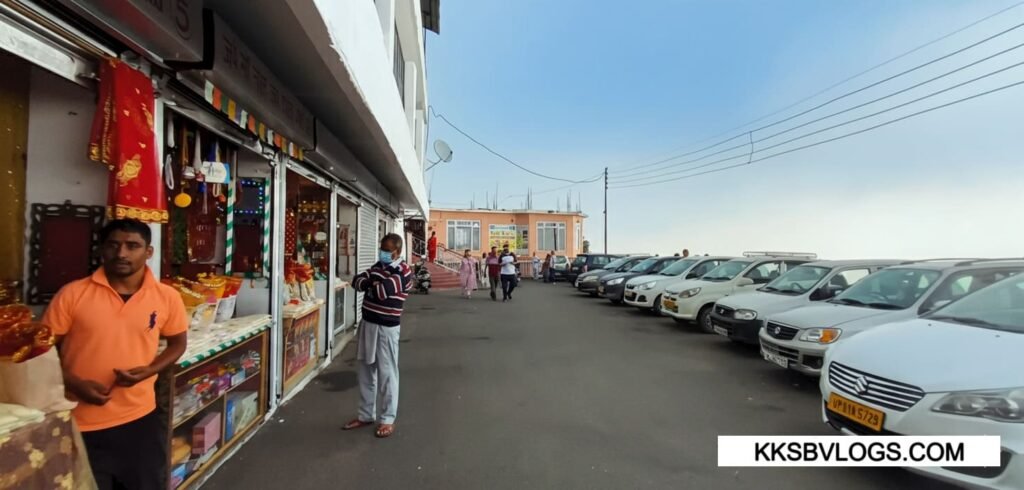
6.1 By Road (Best Option)
The easiest way is a 45-minute drive from Shimla via NH-22, with a direct side road to the hilltop.
Taxis and private cabs are widely available from Mall Road. Self-driving is possible, but the final stretch is steep and narrow, so drive carefully.
6.2 By Train (Toy Train)
Take the Kalka–Shimla heritage railway to Tara Devi station, which is 8-9 km from the temple. From there, hire a taxi, catch a local bus, or trek.
This route is scenic, with tunnels, bridges, and forested valleys.
6.3 By Trek
Adventurous travelers can hike 5 km through pine and oak forests, a journey that blends nature and spirituality.
Time: 1.5–2 hours (moderate difficulty).
Best seasons: post-monsoon and winter.
6.4 By Air
The nearest airport is Shimla Jubarhatti (25 km).
For better connectivity, fly to Chandigarh Airport (115 km) and drive about 3.5–4 hours.
✨ Practical Tip: For elders or small children, road travel is the most convenient option.
7) Best Time to Visit
Tara Devi Temple is beautiful year-round, but each season has its charm:
- March–June (Summer): Pleasant 15–25 °C weather, lush greenery, and clear skies—perfect for trekking and photography.
- July–September (Monsoon): Clouds and mist create a mystical vibe, but trails can be slippery—carry a raincoat and sturdy shoes.
- October–February (Winter): Snow blankets the hills, turning the temple and valley into a postcard scene. Pack warm clothes as temperatures may dip below 0 °C.
✨ Pro Tip: Visit early morning (8–10 am) for fewer crowds and the clearest Himalayan views.
Festival times like Navratri and Ashtami bring the most vibrant spiritual and cultural experience.
7) Best Time to Visit Tara Devi Temple
Tara Devi Temple is open year-round, and each season offers its own charm.
March – June (Summer)
This is the most comfortable season.
The weather stays pleasant (15–25 °C), making it ideal for trekking and hilltop views.
Forests are lush green and skies are crystal-clear—perfect for photography.
July – September (Monsoon)
After the monsoon, the surroundings turn vivid green.
Clouds and mist create a mystical atmosphere around the temple.
However, trails can be slippery—carry a raincoat and non-slip shoes if you plan to trek.
October – February (Winter)
Winter covers Tara Devi Temple and nearby hills in a white blanket of snow, turning the landscape into a postcard scene.
Temperatures can drop to 0 °C or lower, so warm clothing is essential.
✨ Pro Tip for Visitors
The best time to visit is morning (8 am – 10 am) when the crowd is thin and the Himalayan views are clearest.
During festivals such as Navratri and Ashtami, the temple feels spiritually and culturally even more rewarding.
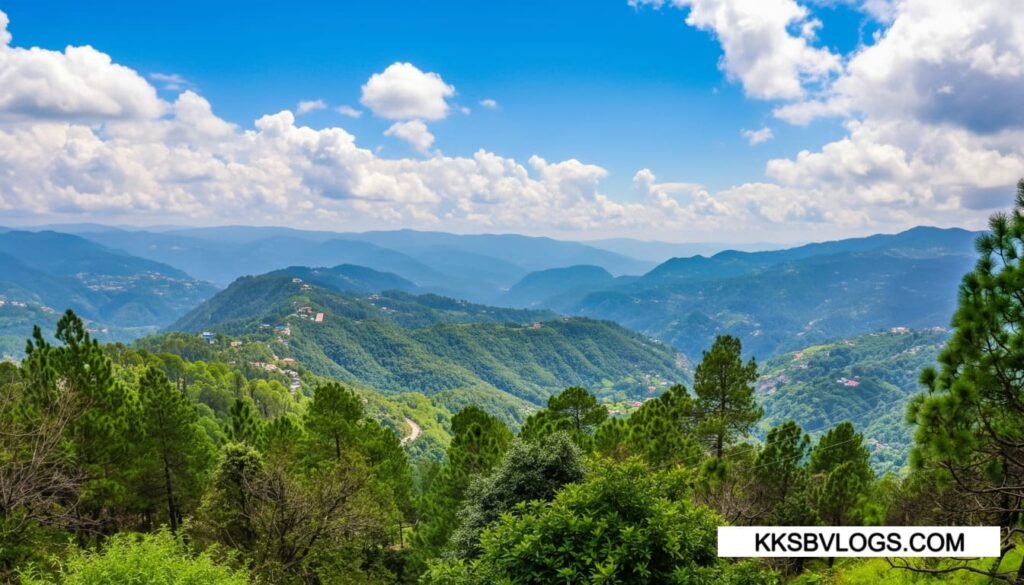
8) Visitor Information
Tara Devi Temple is well-maintained and visitor-friendly.
Here’s what you need to know before your trip:
- Timings: 7:00 AM – 6:30 PM (extended hours on major festivals)
- Entry Fee: Free (no charge for darshan)
Facilities Available
- Hilltop parking area
- Clean washrooms
- Drinking water facility
- Small stalls selling prasad and snacks
Dress Code
Wear comfortable, modest clothing.
In winter, pack warm layers, and for treks, sturdy sports shoes.
Average Time Required
About 1.5–2 hours, including darshan, photography, and some quiet rest.
Crowd Factor
Compared to Jakhu Temple, Tara Devi Temple is less crowded, making meditation and peaceful darshan much easier.
Safety Tips
- During monsoon, roads can be slippery—drive carefully.
- Carry water and light snacks if trekking.
- Elderly visitors are advised to use road transport or a taxi, rather than trek.
9) Our Experience – Tara Devi Temple, Shimla
Visiting Tara Devi Temple was the most peaceful and soulful part of our Shimla trip.
As soon as we arrived at the hilltop, crisp mountain air and the scent of deodar forests welcomed us.
Entering through the temple gate, the ringing of bells and fragrance of fresh flowers instantly created a divine atmosphere—the true magic of Himachal.
Inside the sanctum, sitting before Goddess Tara’s idol, we felt a deep calm that is hard to find amid Shimla’s bustling tourist spots.
The idol’s gentle yet powerful aura, the soothing sound of bells, and the heartfelt devotion of fellow visitors made it a profound spiritual experience—a memory every hill-station traveler will cherish.
From the open courtyard, the view was breathtaking: Shimla’s rooftops below, the Shivalik ranges in the distance, and valleys wrapped in soft light—like a perfect postcard.
We lingered there, simply enjoying the fresh mountain breeze and profound silence, which felt like paradise for nature lovers and spiritual seekers.
The best part? Unlike Jakhu Temple, Tara Devi Temple remains wonderfully uncrowded.
This allowed us to explore at a slow-travel pace, soaking in every detail of the temple and its surroundings.
It is the perfect destination for those looking for a peaceful spiritual spot near Shimla or a weekend retreat away from city noise.
10) Nearby Attractions
Make the most of your trip by exploring these nearby must-visit places:
- Shimla Ridge & Christ Church (~18 km)
The Ridge is Shimla’s most iconic open space, perfect for evening walks and cultural events.
Nearby stands Christ Church, admired for its stained-glass windows and striking Neo-Gothic architecture. - Mall Road (~20 km)
The lively heart of Shimla, Mall Road offers shopping, heritage cafés, local handicrafts, and colonial-era buildings.
After visiting Tara Devi Temple, a relaxed stroll here is ideal. - Jakhu Temple (~22 km)
Shimla’s highest point, famous for its 108-foot Hanuman statue.
Visiting Tara Devi and Jakhu together makes an excellent spiritual day trip. - Sankat Mochan Hanuman Temple (~13 km)
Situated on the outskirts of Shimla, this peaceful temple is dedicated to Lord Hanuman and offers quiet valley views away from the crowds. - Indian Institute of Advanced Study (IIAS) (~17 km)
A magnificent British-era heritage building that now serves as a research institute.
Its lawns and grand architecture make it a paradise for photographers and history lovers alike.
Tara Devi Temple Location, Photos & Video
YouTube Video:Coming soon on – KKSB Vlogs
Instagram Updates: Stay connected with us for reels and updates– @official_kksb
Tara Devi Temple Photos
Tara Devi Temple Location
FAQs About Tara Devi Temple Shimla
Where is Tara Devi Temple located?
Tara Devi Temple is situated about 18 km from Shimla city on NH-22, atop a scenic hill that offers panoramic views of the Shivalik ranges and pine forests.
What is the best time to visit Tara Devi Temple?
The temple is open all year. March–June is pleasant and great for trekking, July–September offers lush greenery and misty views, and October–February brings snow-clad scenery. Morning (8–10 am) is ideal for clear views and fewer crowds.
How can visitors reach Tara Devi Temple?
You can drive (about 45 minutes from Shimla), take the heritage toy train to Tara Devi station and then taxi or trek 4–5 km, or hike directly through pine forests. The nearest airport is Shimla Jubarhatti (23km).
Is there an entry fee or specific timings?
Entry is free. Regular temple hours are 7:00 am to 6:30 pm, with extended timings on major festival days like Navratri and Ashtami.
What facilities are available at the temple?
Visitors will find parking at the hilltop, clean washrooms, drinking water, and small stalls selling prasad and snacks, making it a convenient and family-friendly spot.
Why is Tara Devi Temple spiritually significant?
Dedicated to Goddess Tara (a form of Shakti), the temple symbolizes protection, courage, and guidance. Devotees believe visiting brings mental clarity and blessings for life decisions, travel safety, and prosperity.
Are there any festivals or special celebrations?
Yes. Navratri is the grandest celebration, with daily aartis, bhajans, and community feasts. Ashtami and Purnima also feature special pujas and bhandaras. The Tara Devi Mela showcases local music, dance, and crafts.
Which other attractions can be combined with a Tara Devi Temple trip?
Nearby highlights include Shimla Ridge & Christ Church, Mall Road, Jakhu Temple, Sankat Mochan Hanuman Temple, and the Indian Institute of Advanced Study, all within 15–22 km.

